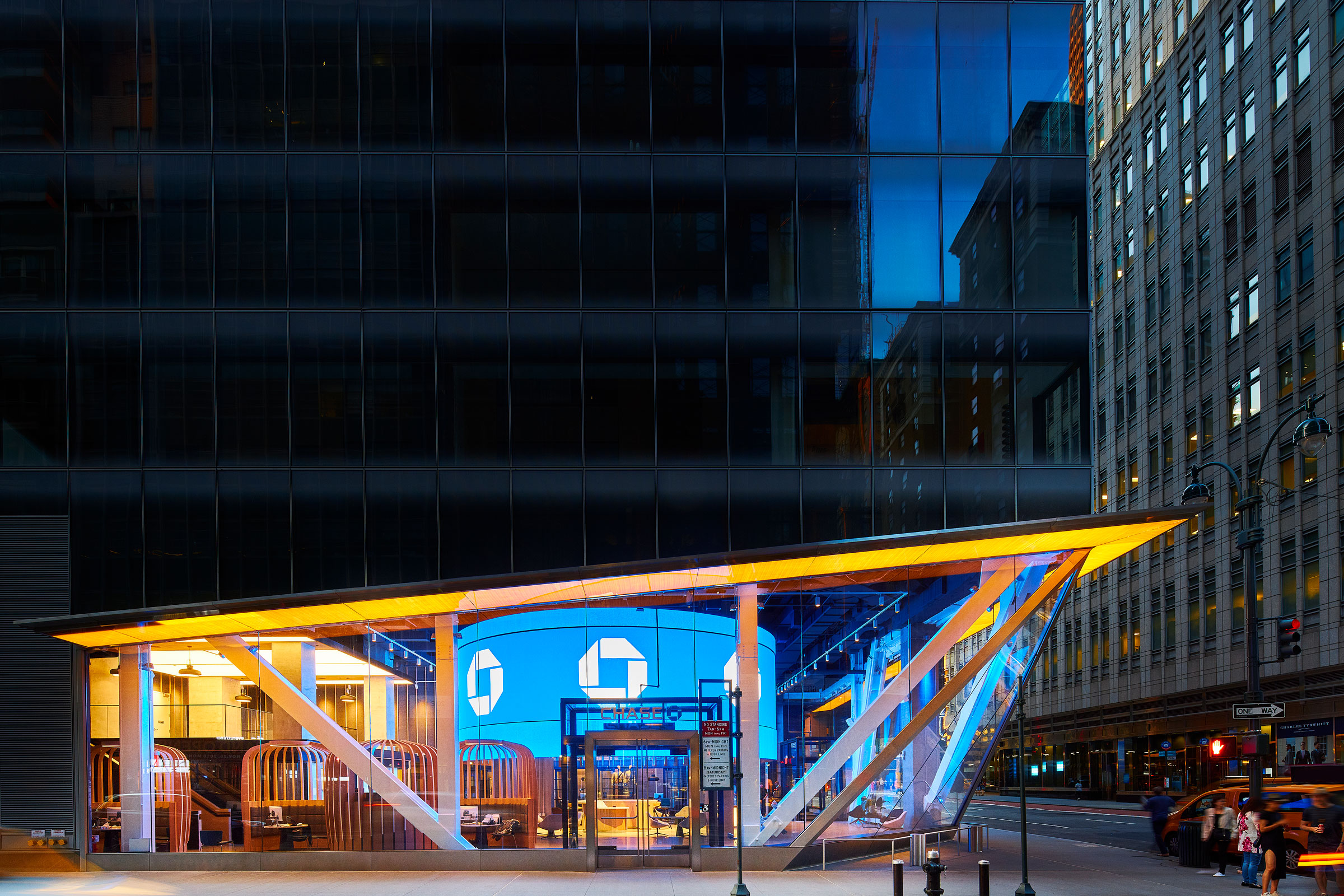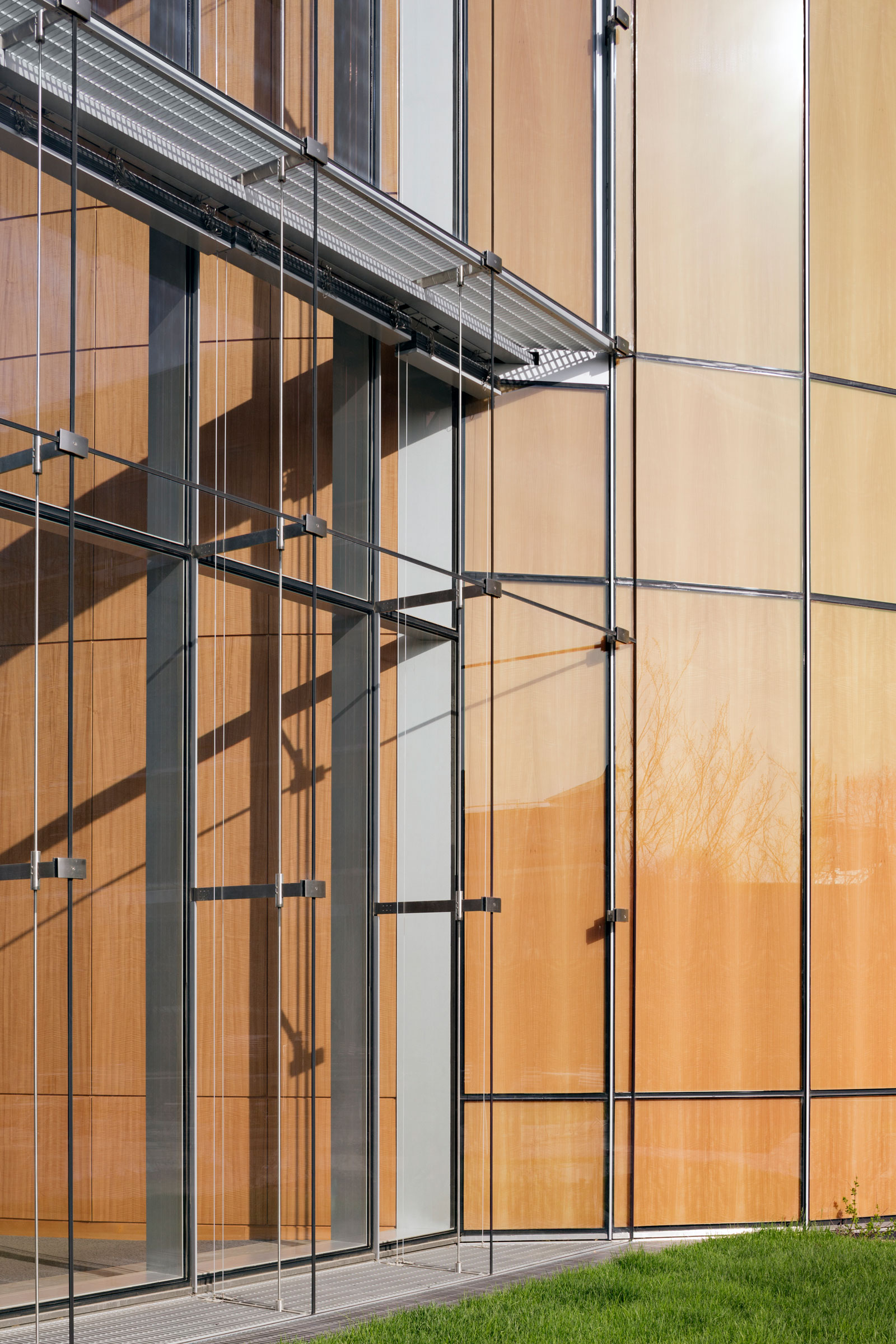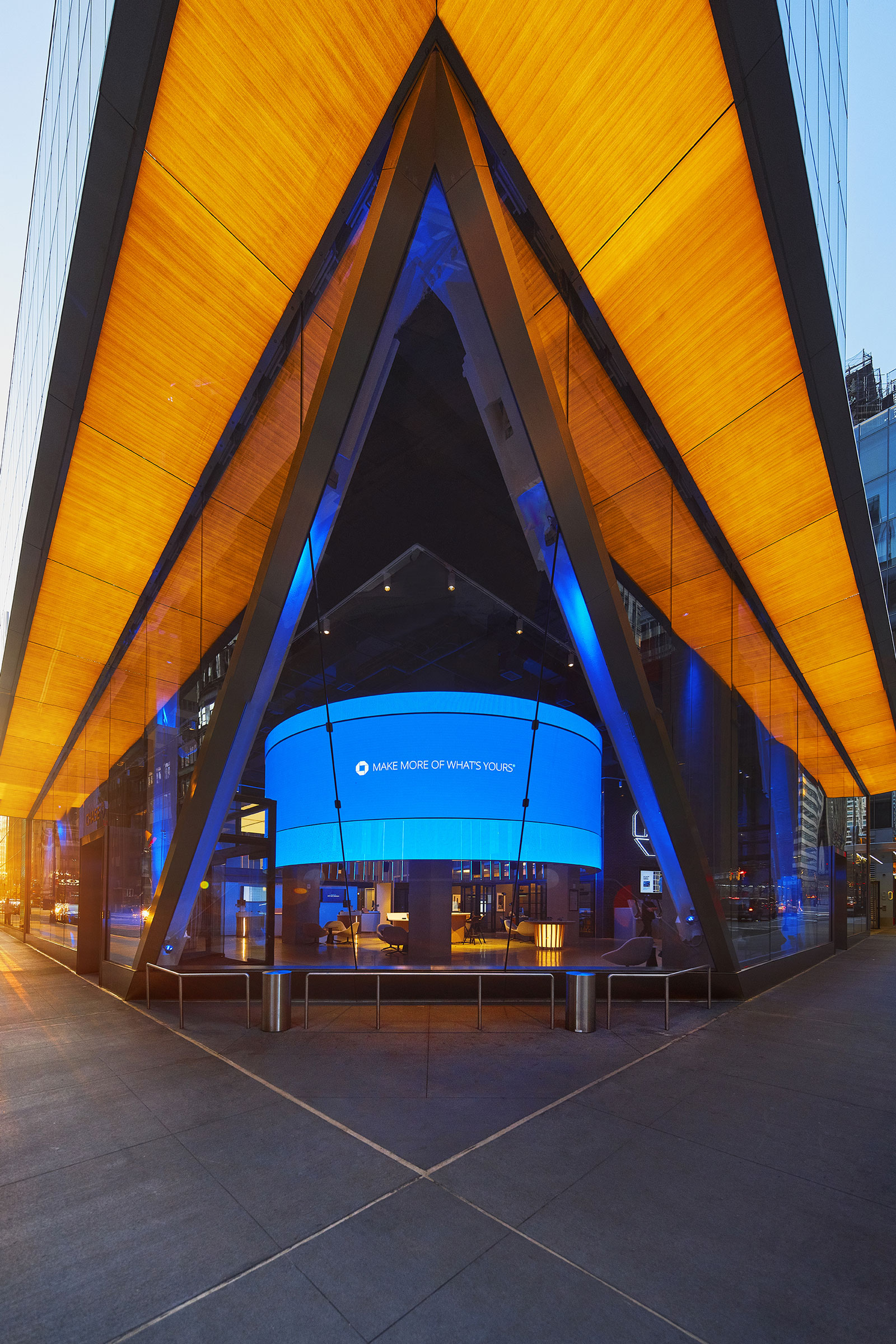Story at a glance:
- GGI has been leading the industry with architectural and specialty glass since 1900.
- Alice direct to glass printing can be used for interior design, architectural, and industrial applications inside and out.
For more than a century General Glass International, or GGI, has been a pillar of the glass industry. The company is family-owned and operated (started in 1900 by Max Balik) and specializes in architectural and specialty glass products—from ceramic inks and textures to bird-friendly glass and more.
The first company to bring the technology to the US in 2008, GGI remains at the forefront of digital direct to glass printing in North America.
Stephen Balik, vice president of business development, represents the fifth generation of the family and leads a team focused on innovation through expansion of product offerings and solutions.
Sustainability
- Tata Hall at Harvard Business School includes a 7-foot tall, double-skinned curtain wall with vented glass layers that helped the project earn LEED Platinum. Photo courtesy of GGI
- This Chase Bank project was beautiful using GGI’s Alice technology. Photo courtesy of GGI
Glass contributes to more sustainable buildings in many ways—from daylight maximization to nature views and thermal comfort, Balik says. Glass in buildings allows natural light to penetrate deeper into interiors, reducing the need for artificial lighting and positively impacting the occupants’ well-being by providing a connection to the outside.
Properly designed glass facades can harness solar heat gain, reducing the need for heating during colder months and contributing to energy efficiency and climate control. Using glass to allow sunlight to passively heat the interior spaces can also lead to reduced energy consumption and a more comfortable indoor environment.
Of course, glass also means sight, and views of nature are in demand, Balik says. Transparent glass facades offer occupants access to outside views, which have been proven to improve productivity, reduce stress, and enhance the overall well-being of people. Incorporating glass elements in buildings can support biophilic design principles, fostering a sense of connection to nature and promoting a healthier and more satisfying living or working environment.
Glass can also be more easily recycled than some other building materials, making it even more environmentally friendly.
Innovation in Action
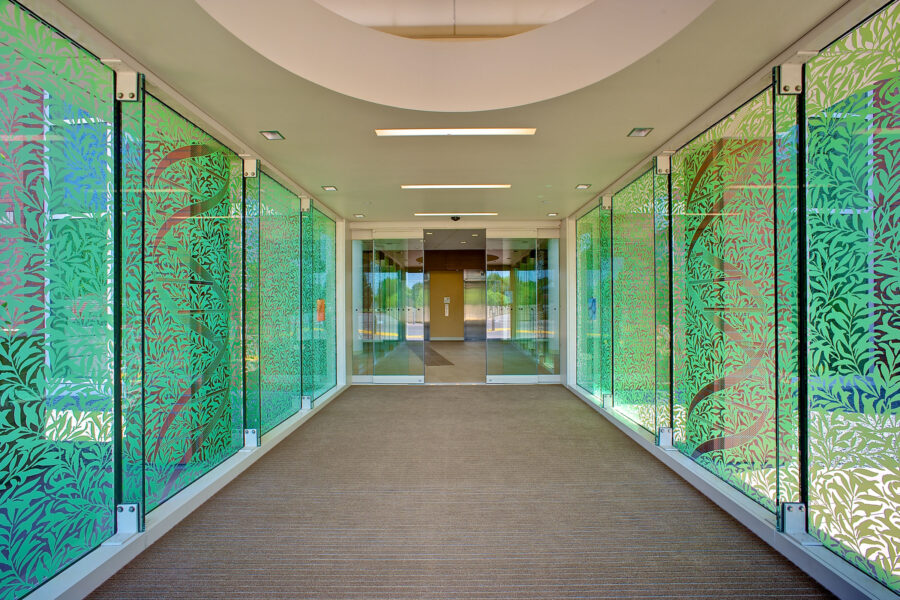
Alice direct-to-glass digital ceramic printing enables any design to be reproduced in glass. Photo courtesy of GGI
With GGI’s Alice® Direct to Glass Printing and opacity control you can have daylighting while incorporating imagery or decorative patterns for privacy and aesthetic benefit. The digital ceramic printing process allows architects, artists, and designers to manipulate art, color, light, and opacity on glass to bring life to any space. A texture or pattern on glass can give the effect of privacy while letting light pass through into an office space or health facility, for example—spaces where people often find themselves inside for long periods of time.
Alice is among GGI’s most impressive products. With it GGI provided a 37-foot tall, double-skinned curtain wall with vented glass layers set 36 inches apart at Tata Hall at Harvard Business School. The design functions as a thermal blanket in colder temperatures and creates a cooling convection in warmer weather. It helped the project earn LEED Platinum. GGI matched wood that the design team sourced from Africa for the project.
“We were handed an actual piece of wood and they simply asked, ‘Can you match this?’ We had never created a replica of a custom material before, but we were ready for the challenge,” Balik says, adding that the success of that project helped GGI go on to launch other exciting faux materials. “We’d never done anything like that before, but we always try to take lessons from past projects and apply them to future product developments.”
A few years later GGI also used the Alice technology at 390 Madison Avenue, a Chase Bank project that involved re-massing a building built in 1955. Balik says it’s another job that uses faux wood materials they could manipulate with light and opacity in a way you couldn’t with real wood. “The Harvard job required some knockouts in the print to allow for natural light to come in, and that also provided some shading in the rooms themselves. While 390 Madison didn’t require knockouts, it did need to be backlit—a different type of lighting challenge solved by opacity control,” he says.
Growing Demand
GGI has seen an increase in consistent funding from cities supporting projects like these, Balik says, and more architects are interested in adopting the technology in their designs—especially as a new way to bring in public art to urban planning. “What once might have been a graffiti mural or a picture hanging on the wall can now be anything from a structural glass windscreen to a full glass curtain wall on a new hospital.”
It’s exciting for us to take traditional styles of existing artwork and convert it into new forms and see installations in previously impossible places.
GGI often works with artists to transform and convert their original artwork to glass, using Alice direct-to-glass printing technology. “It’s exciting for us to take traditional styles of existing artwork and convert it into new forms and see installations in previously impossible places,” Balik says. “We know artists are very close to their work, and we do our best to protect that and their original aesthetic intent. Through our knowledge of the technology and dedication to the sampling process, we develop trusting relationships with the artists. We do our best to explain what’s possible with glass without telling the artist what to do. The possibilities are endless.”
GGI was the first company to adopt such technology in the US more than 15 years ago and has spent years refining the process to get it to what it is today. “There are so many more places where decorative glass can be added to a space than before. It’s really about explaining what’s possible,” Balik says.
Bigger & Better
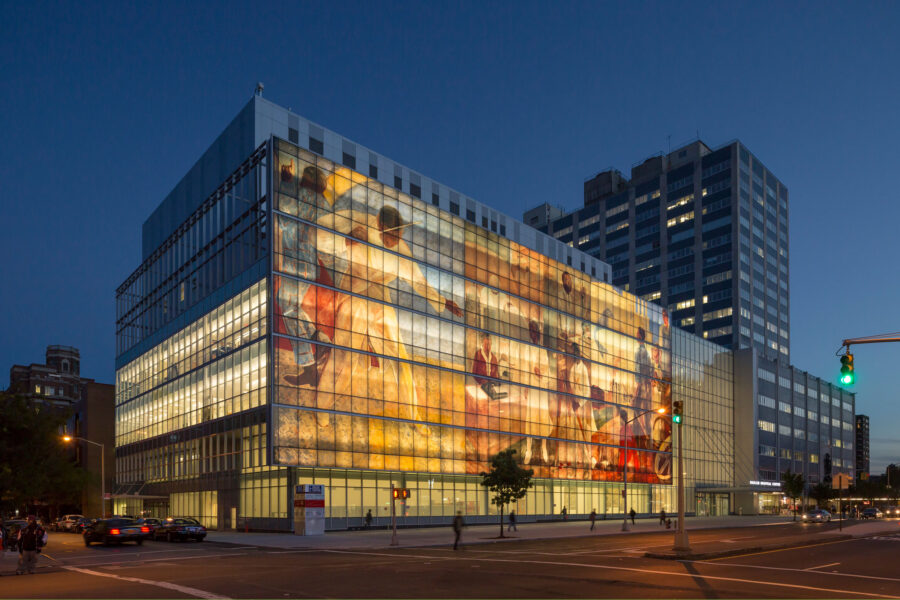
More than 400 low-e laminated, insulated, digitally printed pieces of glass combine in this 13,000-square-foot design that pays homage to historic murals at Harlem Hospital Center. Photo courtesy of GGI
Decorative glass is not as expensive as some folks may expect either, says Spencer Raymond, director of business development at GGI. “I think people look at some of these projects and expect the price for the decorative portion to be much more than it is. The actual production has become much more efficient to utilize different processes and different colors on the same piece of glass, where silk screening wouldn’t have allowed that. There’s a lot more flexibility.”
For the Harlem Hospital GGI converted existing artwork that was hanging in the lobby of the building using digital photography and produced the design at a reduced opacity so the facade looked backlit at night. From the interior each floor running along the facade looks like abstract art, providing privacy as well as light. The architecture firm HOK had narrowed the choice between GGI or a hand-painted option in Germany for the project.
“Instead of hand-painting in Europe we were able to take high-resolution photos of the artwork and use those files to digitally print the full-scale art. Using a digital process gave us a technical advantage in controlling opacity versus the hand-painted option,” Balik says. “We digitally printed these huge panels and laid them out flat on our factory floor to make sure everything aligned from panel to panel. This project was by far the most ambitious of its kind, leading to a nomination for facade of the year among five finalists.”
He says it’s ambitious projects like these that align with their mentality to keep pushing the envelope to produce groundbreaking work. It was one of the largest projects in North America of its type. “Our foundation and competitive edge is our knowledge of the technology and our ability to communicate with artists,” Balik says. “We’re helping bring ideas to glass and to life.”
The Evolution of Glass
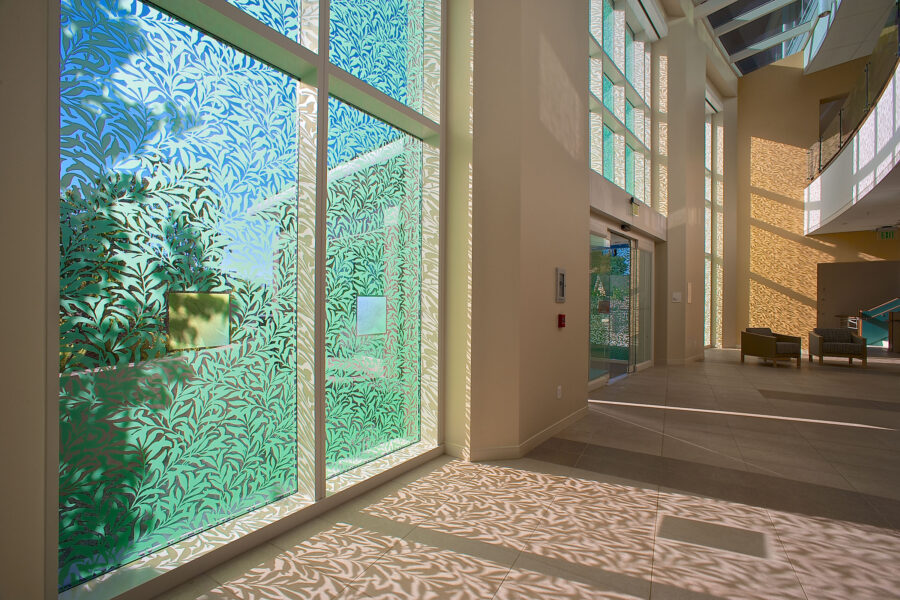
Shadows and light inside the Palo Alto Medical Center. Photo courtesy of GGI
Glass and glazing options have evolved over the years, says Raymond, who’s also grown up in the industry. “Through improvements in hardware and engineered systems, the application choices for glass have grown significantly. Factoring in the durability and nature of ceramic frit, new possibilities of adding decorative components have emerged. You can incorporate design in places you once weren’t able to without sacrificing natural light or building performance.”
Once the digital process was developed for applying ceramic frits the architectural industry recognized it allows for remarkable control of the materials and more flexibility than the silk screening of the past. “What we’re doing is really pushing the hardware and the software side of the process. A lot of it comes down to the software and the programming. It’s the instructions we give when we’re dealing with image files and color layers. It becomes a very complicated process to tell the machine how to lay these pigments and deal with the layering and the glass material.”
Looking Ahead
Balik expects larger glass projects with more complex makeups to continue to be among popular and emerging glass demands. He says glass with more visible light transmission and lower heat gain coefficients are also in demand, as are products that are bird-friendly and easily incorporate daylighting and public art.
GGI offers all of these solutions and more, with more innovations on the way. “Architects should reach out to fabricators, manufacturers, or installers as early as possible to understand what is possible or what solutions exist for their issues,” he says.

